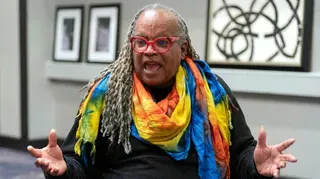June 25, 2013
IAC Report Finds Poor Coverage of High-Risk HIV Groups
Winnie McCroy READ TIME: 5 MIN.
A new report by global advocacy organizations reveals that the prestigious International AIDS Conference (IAC) program continues to lack meaningful coverage of populations most at risk for HIV, including men who have sex with men, transgender people, people who inject drugs (PWID), and sex workers.
"This meager level of coverage on issues concerning our communities at the International AIDS Conference is unacceptable," said Dr. George Ayala, executive director of the Global Forum on MSM & HIV (MSMGF) and co-author of the report. "Not only was there a comparatively low number of abstracts on key populations at the conference, but the content of these abstracts was largely divorced from the most urgent needs of key populations as identified by members of the populations themselves."
The report looks at the topics and countries of abstracts at the 2012 IAC, also known as AIDS 2012, and discovers that key populations were not adequately addressed. According to the quantitative audit, only 17 percent of all abstracts presented were exclusively focused on MSM (8 percent) transgenders (less than 1 percent), injection drug users (5 percent) and sex workers (4 percent).
"After thirty years of AIDS, we know key populations are at much greater risk than the general population in nearly every country around the world," said Allan Clear, executive director of the Harm Reduction Coalition and co-author of the report. "Our communities deserve proper attention, and mounting evidence argues that addressing HIV among key populations is central to ending the global AIDS crisis. It is time for the IAC and the broader AIDS response to start addressing HIV among key populations in a more equitable, more appropriate, and ultimately more effective way."
The program organizers countered this by noting that while "it is true that the percentage of oral abstract sessions which focus 'exclusively' on each of these key populations in comparatively low, if all oral abstract sessions which address these key populations are taken into account, then the numbers increase considerably with 24 percent for MSM, 8 percent for transgender people, 15 percent for PWID and 16 percent for sex workers."
In addition, the audit discovered that nearly 40 percent of abstracts focused on North America and Western Europe, while nearly 2/3 of all key population abstracts were concentrated among 10 countries. Numerous regions with concentrated epidemics among key populations were underrepresented or absent entirely.
"The poor coverage of topics concerning key populations, especially from lower-income countries, may reflect inequitable global funding for research on key populations as much as it reflects the IAC's processes that reinforce these inequities," said JoAnne Keatley, director of the Center of Excellence for Transgender Health at the University of California, San Francisco and co-author of the report. "The IAC's organizers must update the conference's processes to ensure the event is as valuable as possible for addressing the urgent HIV epidemics among key populations. As the premier platform for sharing the latest research on HIV and AIDS, it must lead the global AIDS research field to do the same."
This is the first time that this issue has been examined systematically, so this is new information, although many advocates have suspected it for years. Advocates opine that the disconnect results from a failure to engage community in an effective way. Advocates recommended a number of ways to enhance the efficacy of the conference's community engagement, with a total of 221 organizations from 73 countries endorsing the recommendations for action.
The five recommendations that can be taken by conference organizers to increase meaningful coverage of key populations at future IACs include conducting community consultations, issuing targeted calls for abstracts, making conference locations accessible to key populations, matching abstracts with reviewers based on expertise, and advocating with large funders and research institutions for more appropriate funding and support for research on key populations.
Conference organizers responded to this audit, noting that the International AIDS Society was only one of a number of organizing partners who chose content, among them representatives from UNAIDS, The Global Network of People Living with HIV, the White House, the Black AIDS Institute, the NIH and more.
The audit points to a significant disconnect between topics at the conference and those that stakeholders working directly with key populations said were most important. Some felt that key populations were not adequately represented among the delegates.
"It is difficult for the organizers to verify such claims," read the IAC's response. "It is likely that a number of good quality abstracts on risk factor research were submitted to the programme which affected the final selection of abstracts. As a next step the conference organizers are investigating ways to prioritize abstracts that focus on structural factors; primary prevention; surveillance; and testing, care and treatment."
The auditors refuted that they had presented numerous pieces of evidence to support the claim, including a survey of nearly 300 MSM advocates and service providers designed to identify topics most valuable to address at the IAC.
In the end, the audit recommended that the IAC's systems for engaging community in program development become more transparent, that abstracts be matched with reviewers who are experts in those key populations, and that funding be spread more equitably to address topics that community members and organizations think are most important.
"The IAC represents a unique and powerful opportunity to impact the global AIDS epidemic," said Anastacia Ryan, global policy officer on HIV and Sex Work at the Global Network of Sex Work Projects (NSWP). "The conference offers unparalleled potential to shape the industry's discourse, funding priorities and locus of scientific inquiry, giving key affected populations the recognition they deserve as partners in fighting the epidemic. By updating its processes to increase meaningful engagement with and coverage of key populations, the IAC will not only support the development of more effective strategies to address the needs of key populations, it also will bring the global AIDS response closer to developing the comprehensive solutions we need to end the epidemic."
To read the full report, entitled "Coverage of Key Populations at the 2012 International AIDS Conference," visit http://www.msmgf.org/files/msmgf//Advocacy/AIDS2012_KeyPopulations.pdf.
Winnie McCroy is the Women on the EDGE Editor, HIV/Health Editor, and Assistant Entertainment Editor for EDGE Media Network, handling all women's news, HIV health stories and theater reviews throughout the U.S. She has contributed to other publications, including The Village Voice, Gay City News, Chelsea Now and The Advocate, and lives in Brooklyn, New York.







